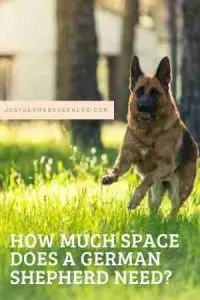 Looking at adding a German Shepherd into your family? One of the biggest factors that you need to consider is space. How much space does a german shepherd need? German Shepherds are wonderful dogs. Full of character, charm and affection. Unfortunately, they are also full of energy, which means there are certain considerations to be made before you decide to bring a GSD home. Originally bred to herd livestock and protect against predators like foxes, German Shepherd today are used as police, fire, therapy and protection dogs. Their intelligence coupled with their high energy makes them perfect for such jobs. As a family dog, this energy needs to be focused on training, activities and appropriate behavior to prevent issues.
Looking at adding a German Shepherd into your family? One of the biggest factors that you need to consider is space. How much space does a german shepherd need? German Shepherds are wonderful dogs. Full of character, charm and affection. Unfortunately, they are also full of energy, which means there are certain considerations to be made before you decide to bring a GSD home. Originally bred to herd livestock and protect against predators like foxes, German Shepherd today are used as police, fire, therapy and protection dogs. Their intelligence coupled with their high energy makes them perfect for such jobs. As a family dog, this energy needs to be focused on training, activities and appropriate behavior to prevent issues.
So, how much space does a German Shepherd need? German Shepherds need enough space to burn off their energy and keep their minds stimulated however, this doesn’t necessarily mean they need a huge yard. As long as your German Shepherd is getting their recommended daily exercise and enough human interaction and stimulation they can happily get on in smaller spaces.
Before you bring a German Shepherd home though you will need to decide whether your home and outdoor space is enough to cater to a German Shepherd’s needs when looking at the amount of daily interaction and exercise you will be able to give them. The following are factors that should all be considered to determine if your space is suitable.
Table of Contents
How much space does a German Shepherd need – Aspects to consider
Age
German Shepherd puppies are small, but they still need room enough to play and explore. Although you will most likely limit them to one or two rooms to begin with, as they age, you will need to allow them more access. They also need a garden or enclosed outdoor space to run and play for short daily sessions.
Crate training is great for puppies as it teaches them boundaries and also provides them a safe space to go to if they want some time to sleep or relax. It is also easier to potty train a puppy if you are crate training.
Adolescent and adult German Shepherds do not tend to do well in apartments if they do not receive proper training. They have a lot of energy to burn and being cooped up in a small space without proper boundaries can trigger stress-related behaviors. Whining, chewing and pacing are all common in dogs who are unable to meet their desire to run and explore.
If you teach your dog early on and keep him on a regular walking and playtime routine, then there is no reason why a German Shepherd cannot live peacefully in an apartment.
If your apartment building has an enclosed space, then your German Shepherd will be fine. They need daily access to an area where they can stretch their legs, investigate new smells, play and go to the toilet. This is in addition to the daily walks they require. A small studio apartment with no outside space is not enough for a large breed dog.
Older dogs tend to require less space as they have lower energy needs. Age tends to reduce the amount of exercise they will need each day and they will not want to run about or play like they did as a pup. For this reason, older German Shepherds would be ok to live in an apartment.
You will need to be mindful that old age may also mean stiff or sore joints, so lots of stairs would not be suitable for an elderly dog.
Energy Levels
Energy levels have a big effect on how much space a German Shepherd needs. High energy levels can have an effect on your dog’s behavior and the safety of your furniture! German Shepherds have very high energy levels and need to be able to burn off their excess energy through play. This requires space, which smaller apartments just don’t have.
Dogs who are not given the opportunity to run off their energy will quickly become stressed and hyperactive. This is usually displayed through destructive behaviors such as scratching and chewing at furniture and doors, pacing, jumping up at people, and excessive barking.
It is also quite common for dogs to vomit if they are not given enough daily exercise. The energy levels build up to a point where the dog’s body cannot cope and it makes them sick. An apartment with access to outdoor space, or a home with a garden is necessary for German Shepherds to be able to play and run about.
Behavior
Lack of exercise leads to unwanted behaviors like barking. In any situation, excessive barking is annoying your neighbors, but if you live in an apartment, this can create some serious neighborhood tension!
Even if your German Shepherd gets plenty of exercises, he is still likely to bark to alert you to potential dangers. As a breed, they tend to bark at strange noises or people passing the house. If you do not teach your German Shepherd how to react correctly to such situations, you could end up with one relentlessly barking dog and lots of angry apartment residents!
Providing your German Shepherd with opportunities to keep himself occupied will help prevent some of these unwanted behaviors, especially if he will be left alone for periods of time.
Treat puzzles are great for getting your dog to focus. He will need to work out the puzzle in order to get the treats. Not only is this great stimulation, but it also stops him from being overly focused on his external environment.
Physical Health
A healthy German Shepherd needs daily walks of at least an hour. In addition, they also need daily playtime at home. Due to their size, a larger yard is better, but it is more important what you do with them in the yard. A walk in the morning and a play session of half an hour to an hour in the afternoon is needed for your German Shepherd to burn off all of his excess energy.
They also like to explore and investigate smells, so a well-used outdoor space means you can hide treats or lay scent trails to give them that extra enrichment.
German Shepherds with physical ailments obviously need less exercise, however, they will still need outdoor access to go to the toilet and get a little fresh air. Apartments in a building without an elevator are not suitable as the stairs would be too difficult for them to manage.
Similarly, if you live in a multi-story house and your German Shepherd has a physical restriction, you will need to limit or prevent their access upstairs. This means they are confined only to the ground floor and any outdoor space you have, so this must also be a consideration. Although a physically ill dog does not require much exercise, they are still a large dog and require space to move about and stretch their legs.
Socialization
German Shepherds need socializing from an early age with both strangers and other dogs to prevent them from becoming reactive or intolerant. This is where living in an apartment can actually be an advantage. Apartment buildings are busy places, with lots of people and dogs to meet. This will give your German Shepherd plenty of opportunities to learn how to interact with neighbors and other friendly dogs.
If you have a reactive dog, you will need to make sure your outdoor space is not encouraging this behavior. Covering your fencing will reduce the triggers for territorial behavior like barking or rushing the fence.
How much space does a German Shepherd Need – Space Requirements
Indoor Requirements
As we mentioned earlier, German Shepherds have different requirements at different stages of their life, but there are other considerations to be made. The layout of your home space is important, particularly during training. Toilet training will go much better if the room your puppy has access to is located close to your outdoor space. Ideally, it will be the room closest to your yard or garden.
Open plan homes are great, as they are generally one large space with very few restrictions. This means you can play inside when the weather is bad or you do not have access to a fenced outdoor space. Homes with a small number of large rooms also provide adequate space for play indoors.
Smaller homes are fine for German Shepherds, but you also need to have a room or part of a room available for your dog to have as his safe space. They will need an area they can go to when they want to get away from the household activity or to have a nap. Small homes make this difficult, but with careful planning it is not impossible.
If you will be crate training your German Shepherd then you need to think about whether there is a suitable room in your house that will fit a large crate, but is also in a quite area and easy to maintain a comfortable room temperature.
Placing a crate in a noisy part of the house means your German Shepherd will not get any rest and he will get frustrated and anxious whenever you have to crate him. This can lead to other behavioral issues.
Crate training allows your dog to see the crate as his safe space, so provided you have room enough for a large crate, then the size of your house shouldn’t be a concern. It is more important to teach your dog how to use the house and give him appropriate places for play, eating and resting.
If you live in an apartment, you will need to have your German Shepherd on a solid toilet routine, as you cannot simply open the door and let them out. You will need to take them on short, leashed trips outside of the building to ensure they have plenty of opportunity to relieve themselves.
Larger homes with multiple exits to the garden also need careful managing. You will need to learn your dog’s signal for needing the toilet or teach him to tell you during the toilet training process. Training your dog to touch a bell tied to a door handle gives your dog a simple way to tell you he needs to go!
Outdoor Requirements
Large dogs need outdoor space. It is as simple as that. However, your yard or garden does not need to be acres. A small enclosed space is perfectly fine, as long as there is room enough to throw a ball or play games with your dog. The ideal size would be approximately 20 feet by 50 feet as a minimum.
The more space you have, the more you can do to keep your dog active and entertained. Setting up a small sand box to hide treats in is a great way to engage your German Shepherd and provide him with mental stimulation.
You can also create scent trails around the garden with food he likes. Strong smelling treats work best for this. He will need to focus on following the trail to find the food at the end where you have hidden it.
Your German Shepherd will be happier in a small yard playing with you, than he would in an acre field without you. GSD thrive on human attention, so even with a smaller outdoor space, he will be absolutely fine if you are out there playing with him.
Safety is also a concern. Since German Shepherds can jump as high as six feet, a short four-foot fence will not keep your dog contained. You do not want him jumping the fence to greet a neighbor dog only for him to get injured. You will need to refence your yard with a tall sturdy material.
Final Thoughts
Try not to place too much importance on space alone. It is the quality of the space that counts. A small yard full of toys and humans to play with is much more appealing to a German Shepherd than an empty field.
Make the most of your space by introducing toys and games. You can purchase a small plastic paddling pool and fill it with sand to create a cheap sandbox for hiding treats. You can also try some agility if you have the room with a tunnel, a small jump, or a few weave poles. Activities like these help to keep your German Shepherd both mentally and physically active.
References
Clarke, A. & Brown, L. (2016) German Shepherds: A Practical Guide for Owners and Breeders, Wiltshire: Crowood.
Daigneault, D. (2019) The Complete Guide to German Shepherds: Selecting, Training, Feeding, Exercising, and Loving your new German Shepherd Puppy, LP Media Inc.
Palika, L. (1995) The German Shepherd Dog: An Owner’s Guide to a Happy Healthy Pet, Volume 3 illustrated edition, United States: Howell Book House Inc.
September Mom, (2009) The German Shepherd, Pittsburgh: Eldorado Ink.

